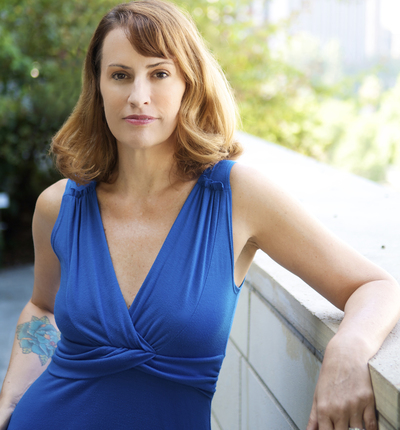 This is an interview with Jill Weiss Ippolito, who is the founder/director of UpRising Yoga in Los Angeles, a nonprofit program that brings yoga to incarcerated youth and communities that can benefit from yoga. Her organization holds weekly yoga classes for boys and girls incarcerated in Central Juvenile Hall, as well as group homes, mental health facilities, and schools across Los Angeles County. Jill is helping to change policy and culture by bringing UpRising Yoga Life Skills training to probation staff, mental health, and social workers, teachers, and the general public. Like others interviewed for this series, Jill says, "Yoga saved my life from a past of jails and institutions, addiction and medications, depression and hopelessness."
This is an interview with Jill Weiss Ippolito, who is the founder/director of UpRising Yoga in Los Angeles, a nonprofit program that brings yoga to incarcerated youth and communities that can benefit from yoga. Her organization holds weekly yoga classes for boys and girls incarcerated in Central Juvenile Hall, as well as group homes, mental health facilities, and schools across Los Angeles County. Jill is helping to change policy and culture by bringing UpRising Yoga Life Skills training to probation staff, mental health, and social workers, teachers, and the general public. Like others interviewed for this series, Jill says, "Yoga saved my life from a past of jails and institutions, addiction and medications, depression and hopelessness."
Rob: What originally motivated you to do this work, and what continues to motivate you? How, if at all, has that motivation changed over time?
Jill: What originally motivated me was hearing about the conditions of the minors in juvenile hall. Incarceration leaves a deep scar on a young person. I felt that yoga could be a powerful tool to help young people cope with a bad situation, and that it could bring more peace to an environment that is continually stressful; so I asked the LA County Probation Department, "Can I teach yoga?"
These kids continue to motivate me, especially the ones who are truly motivated to do this on their own because "it feels good." They light up; they want this yoga. They're sponges, soaking up this gift that can never be taken away from them.
I want to mention something funny around your "motivation" question. It took about three or four months teaching at juvenile hall before I remembered that I was once arrested and brought there myself when I was a teenager. My mother reminded me, and I realized why this work resonates in me so deeply. Would things have been different for me if yoga had been placed in my path earlier in life? The answer to that question doesn't matter for me now, but it might for one of the kids we share yoga with!
Is there a standout moment from your work with juveniles in LA County Juvenile Hall?
A lot of work goes into these classes, and I have a lot of wonderful people helping me. But for me, the best experience I have had is actually practicing with the kids: for instance, a boy next to me asking, "Miss, how can I do this on the outside?" It makes me happy to see the kids eager to get in postures they like (for some reason, Crow is by far the most popular asana we do). It's rewarding to watch them help each other, like one boy telling the guy next to him to be quiet, so he can "get this." During a meditation, one girl said she had the vision of a beautiful pond, a place where, in her mind, she can always go.
What did you know about the population you are working with, before you began teaching? What were some of the assumptions you had about this population and how have those assumptions changed?
As I mentioned, my mother reminded me that I was brought to juvenile hall when I was a teenager. So I guess you could say that my empathy for a young person in that situation went from this more general idea of "Oh, those poor kids" to "I've been there, I can relate." Also, the idea of kids in foster care was hard to imagine. I knew of foster homes, and how many kids run away from them, but the idea of having no one to come pick you up and care for you really started to sink in.
Another big assumption I carried was that the kids would be really tough. I thought they would be hardened and threatening, and I imagined seeing them throw gang signs at each other and fight all the time. I also worried about racial issues: what would happen if the rival gangs were placed next to each other? Would I be breaking up fights all the time? And I thought they would resist the idea of yoga from a white lady: that the boys would think it's "stupid" and the girls would think it's useless. But I was pretty much wrong on all counts. They are sweet kids for the hour we get them. They light up and smile, laugh and share. They ask a lot of questions and are starving for attention, to be seen and to be cared about.
What are two distinct ways that your teaching style differs from the way you might teach in a studio, and what are the reasons for these differences?
UpRising Yoga classes are one hour, and involve education with trauma-informed healing as the focus. This requires relationship-building and understanding cultural diversity. Another fundamental difference is that I am not teaching adults who are there by choice. I'm teaching kids in lockup.
We try to allow a lot of room for the kids to approach yoga in a way that makes them feel safe. We also look for every opportunity to praise and encourage. For some of them, just coming to the mat and lying down is a victory. The next time we come back they may try a posture or two. The time after that, they may do the whole sequence.
What has been the greatest challenge in your teaching experience, and what tools have you developed for addressing that challenge?
I've worked at letting go of what I think a student needs to be doing. Teaching these kids has helped me with that, especially when I see them trying new things in class. My intention is to let each student have his/her own experience.
Compassion is my best tool. Before I start each class, I take a moment to share loving energy to each person there. It's up to me to stay focused in order to offer something grounding.
What advice would you give to anyone who is going to teach juveniles in detention centers?
Make sure you are available, physically and emotionally. What I mean by physically is having the dedication and commitment to show up and be a consistent reliable person in the juvenile department. You have to build trust. Make sure you have time and patience to devote to a program.
Emotionally, make sure you can take care of yourself in a healthy manner while you offer to be of service. We emphasize "being of service" rather than "helping" anyone. Knowing the difference is vital.
What are some of your ideas about or hopes for the future of "service yoga" in America in the next decade?
We have to find a way to offer yoga to kids BEFORE they get in trouble, BEFORE they commit a crime, BEFORE they get arrested.
Editor: Alice Trembour
Image: Courtesy of A+B Photography
